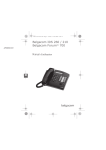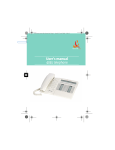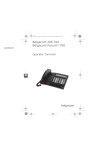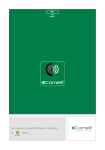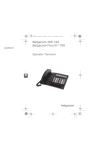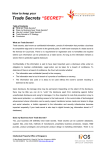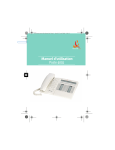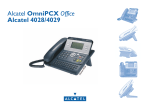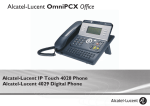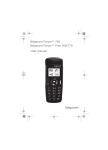Download Manual Forum IDS 210/260
Transcript
FR-2-couverture.fm Page 1 Lundi, 11. août 2003 3:04 15 Belgacom IDS 260 / 210 Belgacom ForumTM 700 First APRGR000-001 User manual 1 User manual AEPMU010-010 how Thank you for choosing one of our, range of telephones, and for your confidence in Belgacom Your digital telephone offers you all the latest design features, so that it is very easy to use, while providing the most efficient means of communication. This easy-to-use telephone offers you: n a receiver that is pleasant to use: it fits nicely in the hand with a flexible grip section(1), n communication is even more convenient using the audio keys (loudspeaker, hands free(2), etc. n using the convenient alphabetic keypad, you can call your correspondents by name(3), n transparent magnifying keys(4) for immediate reading of your programmed settings (direct calls, functions, etc.), 2 Your user-friendly telephone offers you: n a screen that displays your correspondent's number or name and guides your programming operations, n communication icons(5) (busy, free, on hold) to help you manage your calls (switching between calls, etc.), n a complete range of connection interface units for data transmission, assisted telephone applications (CTI*) or easy connection of analogue (fax, answering machine) or ISDN terminals (PC with ISDN board, G4 fax). 1) 2) 3) 4) 5) For the IDS 260 telephone only: Flexible grip sections Hands free Alphabetic keypad Transparent keys Communication icons *CTI : Computer Telephone Integration 2 How to use this guide ? AEPMU000-005 how You have a Belgacom IDS 260 digital telephone. The alphabetic keypad, the screen and the icons will help you use your telephone easily and make optimum use of the many functions offered. • Actions • Audio keys Lift the receiver. Loudspeaker. Hang up. Hands free. Description of an action or context. Adjustment “reduce”. Adjustment “increase”. • Display Smith John Partial view of display. • Programmable keys and icons 3 • Other fixed keys Line key. Fixed key. Icon corresponding to key. MENU key. Key programmed by technician to access service. • Keypad • Other symbols used Numeric keypad. OR Alternative to action sequence. Alphabetic keypad. Specific key on numeric keypad. Important information. These symbols can be supplemented by small icons or text. All default or customized function codes are given in the table of codes in the appended sheet. The features described in this manual and indicated with an asterisk (*) can only be accessed with some software versions. 3 Contents generated Toc Getting to know your IDS 260 telephone . . . . p.8 Getting to know your IDS 210 telephone . . . . p.10 1. Using your telephone . . . . . . . . . . . . . . . . . . . . p.12 1.1 1.2 1.3 1.4 1.5 1.6 1.7 1.8 1.9 1.10 1.11 1.12 1.13 1.14 1.15 1.16 1.17 4 1.18 4 Making or answering a call without lifting the receiver (hands free)* . . . . . . . . . . . . . . . . . . . . . . . . . . . . . . . . . . Making an outside call . . . . . . . . . . . . . . . . . . . . . . . . . . . Making an internal call. . . . . . . . . . . . . . . . . . . . . . . . . . . Calling your correspondent by name (company directory). . . . . . . . . . . . . . . . . . . . . . . . . . . . . . . . . . . . . Calling from your personal directory . . . . . . . . . . . . . . . Calling from the common directory. . . . . . . . . . . . . . . . Receiving a call . . . . . . . . . . . . . . . . . . . . . . . . . . . . . . . . Filtering calls using the voice mailbox. . . . . . . . . . . . . . . Redialling* . . . . . . . . . . . . . . . . . . . . . . . . . . . . . . . . . . . . Temporarily storing a number to call again . . . . . . . . . . Requesting automatic callback if internal number is busy Answering an internal call in intercom mode* . . . . . . . . Sending DTMF signals . . . . . . . . . . . . . . . . . . . . . . . . . . . Making an ISDN call . . . . . . . . . . . . . . . . . . . . . . . . . . . . Hiding your identity (ISDN call) . . . . . . . . . . . . . . . . . . . Identifying a malicious call (ISDN call) . . . . . . . . . . . . . . Activating the loudspeaker during a conversation (receiver lifted) . . . . . . . . . . . . . . . . . . . . . . . . . . . . . . . . Mute, so that your correspondent cannot hear you *. . p.12 p.13 p.13 p.14 p.16 p.16 p.17 p.17 p.18 p.18 p.19 p.20 p.20 p.21 p.22 p.22 p.23 p.23 Contents 2. During a conversation . . . . . . . . . . . . . . . . . . . . p.24 2.1 2.2 2.3 2.4 2.5 Calling a second person during a conversation . . . . . . . Answering a second call during a conversation . . . . . . . Transferring a call . . . . . . . . . . . . . . . . . . . . . . . . . . . . . . Switching between calls (Broker call) . . . . . . . . . . . . . . . Three-way conference with internal and/or external correspondents (conference) . . . . . . . . . . . . . . . . . . . . . 2.6 Placing a call on hold (hold) . . . . . . . . . . . . . . . . . . . . . . 2.7 Placing an outside call on hold (parking) . . . . . . . . . . . . 2.8 Getting information about camped-on calls . . . . . . . . . . 2.9 Intrusion into an internal conversation . . . . . . . . . . . . . 2.10 Store a number* . . . . . . . . . . . . . . . . . . . . . . . . . . . . . . . 3. 5 p.24 p.25 p.25 p.26 p.27 p.28 p.29 p.30 p.31 p.31 Sharing . . . . . . . . . . . . . . . . . . . . . . . . . . . . . . . . p.32 3.1 3.2 3.3 3.4 3.5 3.6 3.7 3.8 3.9 3.10 3.11 3.12 Receiving supervised call ringing . . . . . . . . . . . . . . . . . . . Answering the general bell . . . . . . . . . . . . . . . . . . . . . . . Manager/secretary filtering . . . . . . . . . . . . . . . . . . . . . . . Call pick-up . . . . . . . . . . . . . . . . . . . . . . . . . . . . . . . . . . . Answering briefly in place of the operator. . . . . . . . . . . Monitoring calls to other terminals . . . . . . . . . . . . . . . . Hunting groups . . . . . . . . . . . . . . . . . . . . . . . . . . . . . . . . Calling an internal correspondent on his/her pager. . . . Calling a correspondent on his/her loudspeaker . . . . . . Sending a written message to an internal correspondent Send a voice message copy . . . . . . . . . . . . . . . . . . . . . . . Sending a recorded message to a number / a distribution list . . . . . . . . . . . . . . . . . . . . . . . . . . . . . . . . 3.13 Broadcasting a message on the loudspeakers of a station group . . . . . . . . . . . . . . . . . . . . . . . . . . . . . . . . . . . . . . . . 3.14 Answering a call on your pager . . . . . . . . . . . . . . . . . . . 3.15 Allocating an outside line . . . . . . . . . . . . . . . . . . . . . . . . p.32 p.32 p.33 p.34 p.35 p.35 p.36 p.37 p.37 p.38 p.41 p.42 p.43 p.43 p.44 5 Contents 4. Keep in touch . . . . . . . . . . . . . . . . . . . . . . . . . . . p.45 4.1 4.2 4.3 4.4 4.5 4.6 4.7 4.8 4.9 4.10 4.11 4.12 4.13 4.14 4.15 6 5. p.45 p.46 p.47 p.48 p.49 p.50 p.51 p.51 p.52 p.52 p.53 p.54 p.55 p.56 p.57 Managing your charges . . . . . . . . . . . . . . . . . . . p.59 5.1 5.2 5.3 6 Selecting calls to be diverted . . . . . . . . . . . . . . . . . . . . . Diverting calls to another number (immediate diversion). . . . . . . . . . . . . . . . . . . . . . . . . . . . . . . . . . . . . Diverting your calls to your voice message service . . . . Activate/disable the personal assistant . . . . . . . . . . . . . . Personal assistant: reaching you with one number only Diverting calls to your pager . . . . . . . . . . . . . . . . . . . . . Forwarding your calls from the receiving terminal (“Follow me”) . . . . . . . . . . . . . . . . . . . . . . . . . . . . . . . . . Applying a selective diversion . . . . . . . . . . . . . . . . . . . . . Diverting all group calls. . . . . . . . . . . . . . . . . . . . . . . . . . When you return, cancel all diversions . . . . . . . . . . . . . Diverting calls when your line is busy (divert if busy) . . Do not disturb . . . . . . . . . . . . . . . . . . . . . . . . . . . . . . . . When you return, consult recorded messages . . . . . . . Leaving a recorded message for internal callers . . . . . . Consulting written messages . . . . . . . . . . . . . . . . . . . . . Charging your calls directly to business accounts . . . . . p.59 Finding out the cost of an outside call made for an internal user from your terminal . . . . . . . . . . . . . . . . . . p.59 Charging the cost of an outside call to your company * p.60 Contents 6. Programming your telephone . . . . . . . . . . . . . p.61 6.1 6.2 6.3 6.4 6.5 6.6 6.7 6.8 6.9 6.10 6.11 6.12 7 Initializing your voice mailbox. . . . . . . . . . . . . . . . . . . . . Customising your voice greeting . . . . . . . . . . . . . . . . . . Modifying your personal code . . . . . . . . . . . . . . . . . . . . Selecting ringer tune and adjusting volume . . . . . . . . . . Adjusting screen brightness . . . . . . . . . . . . . . . . . . . . . . Selecting language . . . . . . . . . . . . . . . . . . . . . . . . . . . . . . Programming direct call keys . . . . . . . . . . . . . . . . . . . . . Programming your personal directory . . . . . . . . . . . . . . Programming an appointment reminder . . . . . . . . . . . . Identify the terminal you are on . . . . . . . . . . . . . . . . . . . Broadcasting background music on your loudspeaker. . Locking your terminal . . . . . . . . . . . . . . . . . . . . . . . . . . . p.61 p.62 p.62 p.63 p.64 p.65 p.65 p.66 p.68 p.69 p.70 p.70 Declaration of compliance . . . . . . . . . . . . . . . . p.72 7 Gettingto toknow knowyour yourIDS IDS260 260 Getting telephone telephone Telephone APRMU000-010 To check or modify your key programming. Light indicating messages received. Display The screen displays several pages of information concerning Calling from your personal directory. n Programmable keys and icons To make a call, activate a service or manage your calls. Icons are associated with each of these keys: Line icons: Incoming call (flashing). Call in progress. Mute key so that your correspondent can no longer hear you. Intercom so that your terminal automatically answers a call without having to lift the receiver. Call on hold. Call on common hold. Function icons: Function active Function requiring action. Terminal or line busy. Hang-up key To terminate a call or programming. Preprogrammed function keys: Display new page. Divert your calls to another terminal. three-way conference. n Alphabetic keypad n Audio keys Loudspeaker: to share a conversation to reduce loudspeaker or receiver volume to increase loudspeaker or receiver volume Protected by a flap, used for call by name, message service and programming. You have a self-adhesive 'Memo' label to stick inside the flap. Automatically redial the last number dialled. Access the various mail services. Transfer call to another terminal. Hands free: to make or answer a call without lifting the receiver. ; 8 Telephone generated y programming. Light indicating messages received. Display The screen displays several pages of information concerning the present call. irectory n Programmable keys and icons To make a call, activate a service or manage your calls. Icons are associated with each of these keys: Line icons: Incoming call (flashing). Call in progress. Call on hold. Call on common hold. Function icons: Function active. Function requiring action. Terminal or line busy. Preprogrammed function keys: Display new page. Divert your calls to another terminal. Three-way conference. n Alphabetic keypad er: rsation to increase loudspeaker or receiver volume Protected by a flap, used for call by name, message service and programming. You have a self-adhesive 'Memo' label to stick inside the flap. Automatically redial the last number dialled. Access the various mail services. Transfer call to another terminal. e ut lifting the receiver. 9 Gettingto toknow knowyour yourIDS IDS210 210 Getting telephone telephone Telephone AEAMU000-020 Display Comprises several pages giving information on the current call. Programmable keys and LEDs The keys are divided into line keys, corresponding to the line LEDs, and function keys. Line LEDs Call in progress. Incoming call (flashing). Callback (flashing). Call on hold (flashing). Function LEDs Function active. Some function keys are preprogrammed: Divert your calls to another terminal. Access the various mail services. i Access your personal directory. Automatically redial the last number dialled. Display new page. Transfer call to another terminal. Hang-up key To terminate a call or programming. Light indicating voice messages received or callback requests. Audio keys Loudspeaker: to share a conversation to reduce loudspeaker or receiver volume 10 to increase loudspeaker or receiver volume Installing the programmable key AEPMU000-030 How A printed label is supplied with the terminal. This should be installed beneath the programmable keys. 11 1. 2. 3. 4. Insert a flat “ blade ” into the slot (1 slot per key block). Raise the cover. Slide the printed label into position. Replace the cover. 11 1 AEPMU050-010 Using your telephone Other 1.1 Making or answering a call without lifting the receiver (hands free)* OR OR line key number required you are in hands free mode terminate your call During a conversation, you can lift the receiver without terminating the call. 12 during a conversation * IDS 260 telephone only. 12 AEPMU050-020 1.2 Making an outside call • Making a call: AEPMU050-030 OR “Outside line” key number required 0155667000 tells you the status of your call Using your telephone 1 0 is the default code for an outside line. 13 1.3 Making an internal call OR internal number required default code for “Operator call” function name and number of person called are displayed OR line key 13 Usi 1 AEPMU050-040 1.4 Calling your correspondent by name (company directory) Smith John first letters of your correspondent’s name proposes a name and the corresponding number • If name is OK: make the call • If name is not OK: 14 you can refine the search by adding more characters to the search name or by consulting the various proposals. OR to show the next or previous name to show supplementary information to erase the name shown 14 On IDS 210 telephones: this function requires a “Call by name” programmed key. When the key is pressed: a name is displayed first two letters of correspondent’s name * OR OR show next or previous name enter if name is OK LONG PRESS OR erase name displayed Using your telephone 1 * Enter a letter: the keys on the numeric keypad also correspond to letters which are displayed when you press the key. 15 press once for “A”, “B” or “C” 15 Usi 1 AEPMU050-050 1.5 Calling from your personal directory AEPMU050-060 the system automatically dials the number directory number required (0 to 9) To enter your numbers see 'Programming your personal directory'. On IDS 210 telephones: use the preprogrammed key to access your personal directory: 16 1.6 Calling from the common directory Your terminal has access to a common directory of outside numbers. directory number 16 AEPMU050-070 1.7 Receiving a call AEPMU050-080 your telephone rings Smith John correspondent’s name or number • To answer: OR 1.8 17 Using your telephone 1 Filtering calls using the voice mailbox This service lets you filter incoming calls to your voice mailbox. When your caller leaves his message you can choose to communicate with him. • Activating call screening: programmed key 'Voice mailbox screening' enter your personal code 17 Usi 1 AEPMU050-090 • When you receive a call: you hear the message left by your caller 0155667000 AEPMU050-100 name or number of the caller hands free to take the call OR OR OR lift the receiver 1.9 18 to stop listening only same key to stop listening and deactivate the screening Redialling* OR OR Select the 'Redial' function 1.10 select the No. in the last ten issued Call required number Temporarily storing a number to call again the number called does not reply before hanging up “Temporary number” programmed key number remains stored until another number is recorded 18 AEPMU050-110 • Redialling the stored number: “Temporary number” programmed key On IDS 210 telephones: use the preprogrammed key to access your personal directory: 1.11 Requesting automatic callback if internal number is busy internal number busy OR Using your telephone 1 “Automatic callback if terminal busy” programmed key or function code 19 callback request acknowledged • Cancelling callback request: OR “Cancel automatic callback” programmed key or function code 19 Usi 1 AEPMU050-120 1.12 Answering an internal call in intercom mode* You can answer without lifting the receiver. When you receive an internal call, your telephone rings and you are connected directly in hands free mode. The screen shows the caller’s identity. AEPMU050-130 corresponding LED lights up activate intercom mode cancel intercom mode * IDS 260 telephone only. 1.13 Sending DTMF signals During a conversation you sometimes have to send DTMF signals, such as with a voice server, an automated attendant or a remotely consulted answering machine. 20 during a conversation OR “DTMF End to End” programmed key or function code all the figures dialled are then sent as DTMF signals same key to cancel The function is automatically cancelled when you hang up. 20 AEPMU050-140 1.14 Making an ISDN call screen shows number dialled “ISDN” programmed key number called • To correct the number: OR move cursor Using your telephone 1 • To send the call: LED corresponding to “ISDN” key remains lit up throughout the call 21 • Sending a subaddress: You may have to add a four-digit subaddress to your correspondent’s number (to obtain a fax, PC, telephone, etc.). “ISDN” programmed key enter subaddress on keypad number called “SubAdd” programmed key validate and send call 21 Usi 1 AEPMU050-150 1.15 Hiding your identity (ISDN call) When you call an internal or an outside ISDN number, your number is automatically sent. You can hide your identity before sending your call. AEPMU050-160 hidden identity remains active while key icon is lit up “Secret” programmed key same key to cancel 22 1.16 Identifying a malicious call (ISDN call) When you receive a call, you can ask the network operator to record informations about your communication (correspondents’ numbers, date and time of call, subaddress, etc.). during a conversation code for function 'Identify malicious call' service request acknowledged Using this service requires to take out a subscription to the network operator. 22 AEPMU050-170 1.17 Activating the loudspeaker during a conversation (receiver lifted) AEPMU050-180 During a call OR activate loudspeaker adjust volume (7 levels) deactivate loudspeaker 1.18 Mute, so that your correspondent cannot hear you * • You can hear your correspondent but he/she cannot hear you: 23 Using your telephone 1 corresponding LED lights up during a conversation disable microphone resume the conversation * IDS 260 telephone only. 23 Usi 2 During a conversation AEPMU060-010 Other 2.1 Calling a second person during a conversation during a conversation OR number of second correspondent name of second correspondent* OR OR line key directory number required (0 to 9) the first call is on hold 24 • To cancel your second call and recover the first: line key for which icon is flashing If you make an error, hang up: your telephone will ring and you will recover your first call. * IDS 260 telephone only. 24 AEPMU060-020 2.2 Answering a second call during a conversation • A second correspondent is trying to call you: AEPMU060-030 during a conversation Smith John caller's name or number flashing for 3 seconds line key for which icon is flashing the first call is on hold • To recover your first call: During a conversation 2 25 line key corresponding to icon If you hang up without answering the second call, your telephone will ring. 2.3 Transferring a call • To transfer your call to another number: during a conversation the first call is on hold number required 25 Dur 2 AEPMU060-040 • If the number receiving the transfer answers: OR if allowed by system configuration You can also transfer your call immediately, without waiting for the number to answer, using either of the two methods described above. Transfer between two outside calls is not generally possible (depends on country concerned and system configuration). On IDS 210 telephones: use the preprogrammed key to access the “Transfer” function: 26 2.4 Switching between calls (Broker call) During a conversation, a second call is on hold. To accept the second call: the first call is on hold line key corresponding to icon 26 AEPMU060-050 2.5 Three-way conference with internal and/or external correspondents (conference) During a conversation, a second call is on hold. three-way conference cancel conference and return to first correspondent hang up on all correspondent 27 During a conversation 2 After the conference, to leave your two correspondents talking together: 27 Dur 2 AEPMU060-060 2.6 Placing a call on hold (hold) • Exclusive hold: During a conversation, you wish to place the call on hold and recover it later, on the same telephone. your call is placed on hold line key • Recover the call on hold: line key corresponding to icon 28 • Common hold: To recover your call on any telephone in your system. your correspondent is placed on hold and hears the holding tone “Hold” programmed key • Recover the call on hold from any telephone: line key corresponding to icon 28 AEPMU060-070 2.7 Placing an outside call on hold (parking) You can place an outside call on hold and recover the call on another telephone: During a conversation OR “Park call” programmed key or function code your correspondent is placed on hold and hears the holding tone • To recover the parked call: 29 During a conversation 2 OR “Retrieve parked call” programmed key or function code number of telephone from which call was parked If the parked call is not recovered within a preset time (default value 1 min 30), it is transferred to the operator. 29 Dur 2 AEPMU060-080 2.8 Getting information about camped-on calls • Another call is received: during a conversation, you hear a beep beep call is automatically placed on hold Smith John identity shown briefly • You wish to take the call immediately: first call is automatically placed on hold 30 line key corresponding to icon If several calls are received simultaneously, only the last one is shown. 30 AEPMU060-090 2.9 Intrusion into an internal conversation Your correspondent’s line is busy. If the number is not “protected” and if authorised, you can intrude into the call: AEPMU060-100 OR 'Intrude on a call' programmed key code for function 'Intrude on a call' same key to cancel • Protection against intrusion: OR 31 “Protect a call” programmed key or function code During a conversation 2 recorded message No. Protection is cancelled when you hang up. 2.10 Store a number* To store the displayed number in the personal directory while a communication is in progress: select a record in the directory enter the name of your correspondent apply (twice) 31 Dur 3 Sharing AEPMU070-010 Other 3.1 Receiving supervised call ringing To receive the special ringing for calls to another number: AEPMU070-020 “Supervised call ringing” programmed key same key to cancel This service must have been programmed by your installation technician. 3.2 32 Answering the general bell When the operator is absent, outside calls to the operator are indicated by a general bell. To answer: OR “Answer general bell” programmed key or function code 32 AEPMU070-030 3.3 Manager/secretary filtering System configuration allows “manager/secretary” groups to be formed, so that the manager’s calls can be directed to one or more secretaries. • From the manager’s or secretary’s telephone: Sharing 3 calls to manager’s number are filtered by the selected person (secretary, for example) “Filter” programmed key same key to cancel 33 Filtering is indicated on the manager telephone screen and on the programmed keys of the manager and secretary telephones. 33 Sha 3 AEPMU070-040 3.4 Call pick-up You hear a telephone ringing in an office where no-one can answer. If authorised, you can answer the call on your own telephone. • If the telephone ringing is in your own pick-up group: OR “Group call pick-up” programmed key or function code • If the telephone ringing is not in your pick-up group: OR “Terminal call pick-up” programmed key or function code 34 Enter number of ringing telephone The system can be configured to prevent call pick-up on certain telephones. 34 AEPMU070-050 3.5 Answering briefly in place of the operator Outside calls to the operator will ring on your telephone and you can answer the call: AEPMU070-060 Sharing 3 your telephone will ring at the same time as the switchboard “Operator help” programmed key same key to cancel • Calls to the switchboard: 35 calls to the switchboard will ring on your telephone “Operator help” programmed key 3.6 Monitoring calls to other terminals Calls to other numbers can be directed to any telephone (max. 8 numbers per programmed key): your telephone will ring at the same time as the others “Monitoring” programmed key same key to cancel 35 Sha 3 AEPMU070-070 3.7 Hunting groups • Hunting group call: AEPMU070-080 Certain numbers can form a hunting group and can be called by dialling the group number. • Temporary exit from your hunting group: OR “Hunting group out' programmed key or function code your group number • Return into your group: OR 36 “Hunting group in' programmed key or function code your group number Belonging to a group does not affect the management of direct calls. A specific telephone within a group can always be called by using its own number. 36 AEPMU070-090 3.8 Calling an internal correspondent on his/her pager The number called does not answer and you know that the person called has a pager: Sharing 3 OR number called “Paging” programmed key or function code paging in progress is displayed Your correspondent can answer from any telephone in the system. 37 3.9 Calling a correspondent on his/her loudspeaker Your internal correspondent does not answer. If authorised, you can remotely activate your correspondent’s phone: “Forced” programmed key you are connected to the loudspeaker on your correspondent’s phone (if he/she has the hands free function) 37 Sha 3 AEPMU070-100 Sending a written message to an internal correspondent 3.10 OR Message number called OR Malvei first message in list (max. 27) read all messages send selected message 38 scroll through the messages OR OR 38 enter the first letters of the name change language of message exit from mail service • If selected message has to be completed: OR enter appropriate data erase entry send selected message Sharing 3 On IDS 210 telephones: use appropriate preprogrammed key to access “Message” or “Transfer” function: LONG PRESS erase entry 39 39 Sha 3 • The 27 standard messages are shown below: 1 Call me back 15 Meeting on ___ (*) 2 Call me back tomorrow 16 Meeting on ___ at _:_ (*) 3 Call me back at _:_ (*) 17 Out for a while 4 Call back _____ (*) 18 Absent for the rest of the day 5 Call the attendant 19 Absent, back at _:_ (*) 6 Call the secretary 20 Absent, back on ___ at _:_ (*) 7 I will call back at _:_ (*) 21 On vacation, back on ___ (*) 8 Use paging 22 External meeting 9 Please fetch your fax 23 External meeting, back on ___ (*) 10 Please fetch your mail 24 I am in room nr __ (*) 11 Please cancel your forwarding 25 In a meeting - do not disturb 12 Visitors are waiting 26 At lunch 13 You are expected at reception 27 Indisposed 14 Meeting at _:_ (*) (*)Messages to be completed using numeric keypad 40 40 AEPMU070-110 3.11 Send a voice message copy display number of new and old messages Sharing 3 OR personal code select message to copy OR copy message number called correspondent’s name apply 41 OR OR add a correspondent record a comment send message On IDS 210 telephones: use the preprogrammed key to access the “Message” function: 41 Sha 3 AEPMU070-120 3.12 Sending a recorded message to a number / a distribution list personal code OR correspondent’s no. or list no. correspondent’s name or list name apply Ready to record OR 42 add a correspondent record message Are you sure ? Recording ... recording end of recording OR OR apply replay message re-record a message On IDS 210 telephones: use the preprogrammed key to access the “Message” function: 42 AEPMU070-130 3.13 Broadcasting a message on the loudspeakers of a station group A message not requiring an answer can be broadcast on the loudspeakers within your broadcast group: AEPMU070-140 Sharing 3 speak, you have 20 seconds number of broadcast group The message will only be broadcast on terminals not in use and which have a loudspeaker. 3.14 43 Answering a call on your pager A call on your pager can be answered from any telephone within the system. your pager beeps “Answer paging” function code your extension number 43 Sha 3 AEPMU070-150 3.15 Allocating an outside line If authorised, you can transfer an outside line to another terminal, thus enabling that person to make an outside call. during an internal conversation “Allocate outside” programmed key your internal correspondent now has an outside line and can dial To know the cost of the call, press the “Allocate & charge” programmed key instead of the “Allocate outside” key, to allocate the line (see “Managing your charges”). 44 44 4 Keep in touch AEPMU080-010 Other 4.1 Selecting calls to be diverted When a diversion is applied, you can select the types of call to be diverted: outside, internal, all. message “4-Div” is displayed OR set “7-ExtLoc” (consecutive presses) divert internal and outside calls divert outside calls OR 45 divert internal calls apply your choice 45 4 AEPMU080-020 4.2 Diverting calls to another number (immediate diversion) The number can be your home, portable or car phone, voice message or an internal extension (operator, etc.). OR diversion key or “Immediate diversion” function code number called diversion is acknowledged OR your telephone is no longer active 46 diversion is displayed, with number or name to which the calls are diverted General remark concerning diversions: the number to which your calls are diverted can be programmed. However, if the programmed number is not being answered, another diversion number should be entered when the function is activated. You can make calls, but only the destination number can call you. 46 AEPMU080-030 4.3 Diverting your calls to your voice message service OR OR programmed key or code for type of diversion required Keep in touch 4 number of message service 47 47 Ke 4 AEPMU080-040 4.4 Activate/disable the personal assistant personal assistant display status personal assistant OR to activate personal assistant 48 48 to deactivate personal assistant apply AEPMU080-050 4.5 Personal assistant: reaching you with one number only personal assistant dial number of a colleague or your secretary dial an outside line number select type of diversion Keep in touch 4 dial number of your DDS or DECT 49 activate/ deactivate transfer to operator 49 Ke 4 AEPMU080-060 4.6 Diverting calls to your pager Callers will thus be able to contact you while you are moving around the company: AEPMU080-070 OR OR “Divert to paging” programmed key or function code diversion is acknowledged OR message “4-Div” is displayed 50 diversion is acknowledged 50 AEPMU080-080 Forwarding your calls from the receiving terminal (“Follow me”) • You wish to receive your calls in your present location: 4.7 Use the “Follow me” function. OR “Follow me” programmed key or function code your extension number Keep in touch 4 message “4-Div” is displayed OR 51 your extension number 4.8 Applying a selective diversion You can selectively divert calls, according to the caller’s identity: OR “Selective diversion” programmed key or function code same key to cancel To use this function, the selective diversion lists must be programmed. 51 Ke 4 AEPMU080-090 4.9 Diverting all group calls You can divert all your group calls to another internal number: AEPMU080-100 OR “Divert group calls” programmed key or function code number receiving diversion diversion is acknowledged 4.10 52 OR When you return, cancel all diversions OR OR “Cancel all diversions” programmed key or function code acknowledgement of cancellation of diversion is displayed. Your telephone will again receive all incoming calls OR message “4-Div” is displayed A diversion can also be cancelled by programming another type of diversion. 52 AEPMU080-110 4.11 Diverting calls when your line is busy (divert if busy) OR “Divert if busy” programmed key or function code diversion is acknowledged number receiving diversion Keep in touch 4 OR message “4-Div” is displayed OR 53 number receiving diversion 53 Ke 4 AEPMU080-120 4.12 Do not disturb You can make your terminal temporarily unavailable for all calls. OR OR “Do not disturb” programmed key or function code “Do not disturb” message is displayed OR 54 54 message “4-Div” is displayed AEPMU080-130 4.13 When you return, consult recorded messages The light indicates that messages have been received. personal code Keep in touch 4 display number of new and old messages message broadcasting OR replay message 55 OR OR call back sender of message erase message OR select message OR copy message On IDS 210 telephones: use the preprogrammed key to access the “Message” function: 55 Ke 4 AEPMU080-140 4.14 Leaving a recorded message for internal callers You can leave a message on your terminal which will be displayed on the screen of the terminal calling you. Malvei “Divert to text” programmed key first of the 27 messages follow instructions to select message Message is selected in the same way as in: Sending a written message to an internal correspondent. 56 56 AEPMU080-150 4.15 Consulting written messages The light indicates that messages have been received. number of messages received is displayed Keep in touch 4 name of first person to call back is displayed number of sender of message is displayed OR 57 display date and time of message display contents of message OR OR read complete message call the person back * OR OR go to next message erase message previous message terminate consultation * Calling the person back automatically erases the message. 57 Ke 4 On IDS 210 telephones: use the preprogrammed key to access the “Message” function: LONG PRESS 58 58 erase message displayed 5 Managing your charges AEPMU090-010 Other 5.1 Charging your calls directly to business accounts You can charge the cost of your outside calls to business account numbers. AEPMU090-020 OR “Business account code” programmed key or function code number of business account • Adding or changing a business code during a call: “Business account code during call” programmed key 5.2 59 Finding out the cost of an outside call made for an internal user from your terminal in conversation with the internal user OR “Meter Total Recall” programmed key or function code the call is placed on hold outside number called transfer call to your correspondent on hold 59 5 AEPMU090-030 • At the end of the call, you are called back and you can: 1.Read information concerning call (cost, duration, number of units...). 2.Print a charge ticket. twice On IDS 210 telephones: use the preprogrammed key to access the “Transfer” function: 5.3 60 Charging the cost of an outside call to your company * If authorised, when travelling or from home, you can call a public network subscriber and charge the cost of the call to your company. your company’s number extension number and check code *For more details, contact your system manager. 60 public network number 6 Programming your telephone AEPMU100-010 Other 6.1 Initializing your voice mailbox light flashes enter your personal code then record your name according to voice guide instructions Your personal code is used to access your voice mailbox and to lock your telephone. 61 On IDS 210 telephones: use the preprogrammed key to access the “Message” function: 61 6 AEPMU100-020 6.2 Customising your voice greeting You can replace the greeting message by a personal message. AEPMU100-030 voice message service Are you sure ? Recording ... recording end of recording OR 62 apply 6.3 to return to the default message Modifying your personal code Your personal code is used to access your voice mailbox and to lock your telephone. options old code (4 digits). new code (4 digits) personal code apply As long as your voice mailbox has not been initialized, personal code is 0000. 62 AEPMU100-040 6.4 Selecting ringer tune and adjusting volume You can select your ringer tune (choice of 8) and adjust the volume (1 to 7). tune number and volume are displayed OR 63 consecutive presses to obtain tune (8) consecutive presses to adjust volume (7) exit Programming your telephone 6 63 Pro 6 AEPMU100-050 6.5 Adjusting screen brightness screen brightness icon is displayed consecutive presses exit 64 Levels of brightness are scaled from 4 to 16. 64 AEPMU100-060 6.6 Selecting language AEPMU100-070 options selecting the language (key 1 or 2) 6.7 language apply your choice Programming direct call keys 65 0_. . . . . . . press programmed key enter the number Programming your telephone 6 present value of selected key apply 65 Pro 6 AEPMU100-080 6.8 Programming your personal directory Name : directory number (0 to 9) current name is displayed OR erase current name enter new name OR 0_. . . . . . . 66 current number is displayed erase current name internal or outside number to be entered apply Press the '<-' key on the alphabetic keypad to delete a character. • On IDS 210 telephones: Name : directory number (0 to 9) 66 current name is displayed LONG PRESS OR erase current name 0_. . . . . . . current number is displayed enter new name * LONG PRESS erase current name OR 67 internal or outside apply number to be entered * Enter a name : the keys on the numeric keypad also have letters which can be displayed by consecutive presses. Programming your telephone 6 press once for “A”, twice for “B” and three times for “C” OR move cursor left or right 67 Pro 6 AEPMU100-090 6.9 Programming an appointment reminder • To programme a temporary appointment reminder (one callback within the next 24 hours): Temporary Appt temporary appointment time (2 digits for hours, 2 digits for minutes) 68 apply Appointmnt: for a temporary reminder • To programme a permanent appointment reminder (callback every day at the same time): permanent appointment apply 68 appointment time AEPMU100-100 • At the programmed time, your telephone rings: to acknowledge If you are in conversation, the display flashes, a tone is sent and you will hear a beep. After three unanswered calls, a temporary callback request will be cancelled but a permanent callback request will remain in memory.If your calls are diverted to another terminal, the diversion is not applied to the reminder call. • To cancel your reminder request: Temporary Appt 69 6.10 Programming your telephone 6 Identify the terminal you are on Press this key twice. 69 Pro 6 AEPMU100-110 6.11 Broadcasting background music on your loudspeaker You can broadcast background music on the loudspeaker of your telephone (depending on configuration): AEPMU100-120 when telephone is not in use, background music is played same key to cancel The music stops when a call is made or received and starts again when you hang up. 70 6.12 Locking your terminal This service enables you to prevent any outside calls from being made and prevent any changes to the programming of your terminal: OR “Locking/unlocking” programmed key or function code locking your terminal personal code number (4 digits) unlock your terminal OR personal code number (4 digits) 70 locking your terminal 71 unlock your terminal Programming your telephone 6 71 Pro FR-2-couverture.fm Page 2 Lundi, 11. août 2003 3:04 15 Declaration of compliance howtoc We, Alcatel Business Systems, hereby declare that we assume Digital terminal IDS 260/210 (Alcatel Reflexes 4020/4010) product to be compliant with the essential requirements of Directive 1999/5/CE of the European Parliament and Council. Any unauthorised modification to the product shall render this declaration of compliance null and void. A copy of the original of this declaration of compliance can be obtained by post from: ALCATEL BUSINESS SYSTEMS Technical Services - Approvals Manager 1, route du Dr. Albert Schweitzer F 67408 Illkirch - France 2 3EH 21034 UCAB Ed.01 72 Technical support for your Forum® telephone exchange User instructions . All the user instructions for our Forum® telephone exchanges are available on the included CD ROM, and on our Internet site at: www.belgacom.be/pabx. Diagnosing the problem . In the event of a technical failure or problem, we request that you systematically carry out the following tests before contacting our technical support service. To facilitate the diagnosis, please inform the helpdesk operator(1) of these test results. Our helpdesk can solve certain problems remotely. This will avoid a technician’s visit and reduce repair time considerably. Problem with a telephone connected to your exchange 1. Reset the telephone by unplugging it and plugging it back in again. 2. 3. Check the connections, cables and the various plugs. Try it out with the cables from another telephone that is working properly. Test the defective telephone in another socket into which a functioning telephone is plugged. Problem with a cordless DECT telephone 1. 2. 3. Remove and then reinsert the batteries. Ensure that the charger is properly connected. Test the DECT telephone near each of the antennas. General external or internal communication problem 1. 2. Check that the installation is always powered by 230V. Reset the PABX : press on the button “On/Off” (in top on the right on the front face of the PABX) until the led `POWER' remains lit red. To wait a few minutes that the system starts again. Note: the system will be unusable during this phase of restarting (until 20 min.). If the problem persists, contact our technical support service. (1) Contact our technical support service . If the problem persists after these few tests : Consult our Internet site www.belgacom.be/pabx or contact our technical support 24/24 at the following numbers: – for SMEs and residential customers: 0800/55700 – for large companies 0800/55100 Change your configuration To change your installation, add equipment or adapt the programming on your Forum®, contact our Customer Service Department at the following numbers: – for SMEs and residential customers: 0800/55800 – for large companies 0800/55200 Belgacom SA under public law, Bd. du Roi Albert II 27, B-1030 Brussels, VAT No. BE 202 239 951 Brussels Register of Legal Entities .










































































